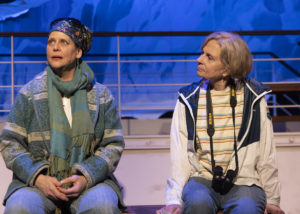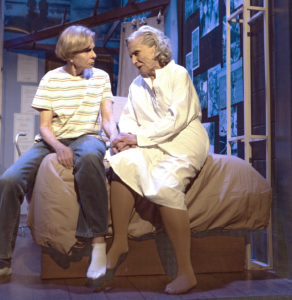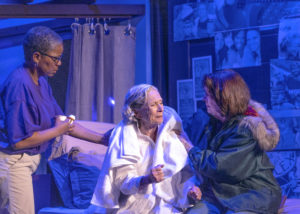
 [rating=3]Light and Sound Productions’ world premiere of “Seven Days at Sea” tells the story of five lesbian women on board an Alaskan cruise ship. The story explores the inner lives of each these older women, including their heartaches and heartfelt moments, including discussing situations about how difficult it can be to identify as gay in a straight world and how to find and express their own inner lesbianism. Considering that most of these women came up in an era where they were expected to have husbands and children, they reflect upon their lives and on social and sexual matters as they have been and as they might have wanted them to be. In spite of details about so many personal tragedies, the plot is fairly easy-going. It’s almost as if the characters are fellow shipmates, and we have all the time in the world to listen to them.
[rating=3]Light and Sound Productions’ world premiere of “Seven Days at Sea” tells the story of five lesbian women on board an Alaskan cruise ship. The story explores the inner lives of each these older women, including their heartaches and heartfelt moments, including discussing situations about how difficult it can be to identify as gay in a straight world and how to find and express their own inner lesbianism. Considering that most of these women came up in an era where they were expected to have husbands and children, they reflect upon their lives and on social and sexual matters as they have been and as they might have wanted them to be. In spite of details about so many personal tragedies, the plot is fairly easy-going. It’s almost as if the characters are fellow shipmates, and we have all the time in the world to listen to them.
Cora (Judi Schindler) and Bailey (Martha Hansen) have been assigned to be roommates in cabin 302, whereas Audrey (Adrianne Cury) and Teresa (Millie Hurley) are fellow travelers in next-door cabin 304. As they come on board ship, the four become acquainted with cruise director/activity director Gloria (Stacie Doublin). Gloria has arranged for a singles “meet-and-greet” and a couples “meet-and-greet.” After the four passengers separately discuss what it means to be either single or a couple, all choose to attend the singles activity. There they all meet up with each other and with the cruise director. The bulk of the show is made up of interactions and conversations among the five of them, and we learn about their past sexual histories and relationships with families and children—and also about their sexual fantasies and desires for a gay relationship today. The story is rife with an array of tales about such issues as abandonment, state intervention in the guardianship of minor children, physical and mental illness, domestic abuse, and suicide. Despite the gravity of all this, the show is not without its humor. Judi Schindler as Cora brilliantly lights up the stage every time she is featured. She is funny; she is kind. Her Georgia accent is endearing. One of the more notable scenes occurs when Cora entices Bailey to share her bed. This intimate scene is very well done, thanks in part to intimacy coach Laura Sturm, who has also supervised other close contact among actors within the show.
As director, Margaret Knapp cleverly and cleanly moves the action along to various parts of the stage. Especially interesting is how she uses the center bed of the three as part of cabin 302 in one scene and cabin 304 in another. The multi-level staging provides just the right setting for all these conversations, which take place inside the cabins, on board deck, and at a shared dining table. Thanks to set designer Michelle Lilly and props design by Jennifer Lazarevic for such wonderful staging! I particularly liked how the restrooms are shielded with thick shower curtains that separate the spaces on stage, so we can infer what’s happening behind them. The center bed, which rolls into the half wall, is clever in its simplicity, and the way that the rooms are decorated with pillows and spreads, to be replaced by chairs and a table, is nicely done. We see posters and photos serving as wall decorations; while towards the back of the stage, we see what appear to be glaciers, carefully hand-drawn, a credit to the fine efforts of the scenic crew, consisting of Emily Kneer and Colleen Schuldeis. By watching this show, one can truly get the feel of actually being on a cruise ship, especially when several characters open the imaginary sliding glass doors to the outdoors, and we hear the whooshing sounds of the wind and the crying and crooning of seagulls. These and other sound effects by sound designer Joyce Ciesel are great, and the sound in general couldn’t be any better! Lighting design by Jessica Nell works very well for this set. Costume designer Christina Leinicke has created very appropriate cruise apparel, from dresses to bathing suits to nightwear.
The first play that Martha Hansen has ever written, “Seven Days at Sea” can be eye-opening for those who do not understand the difficulties involved in being a lesbian in the United States, especially in earlier eras when gay rights were not being recognized. Today there still can be unresolved issues especially among older women, who might not have considered it safe to “come out”, while, at the same time, not necessarily wanting to conform to mainstream heterosexual standards. According to the “Author’s Note” in the playbill, Hansen (who also plays the part of Bailey) was anxious to produce a show that offers the diverse voices of lesbian women in terms of their sexuality and their identity and how this has molded their lives. In addition to being the director, Knapp serves as the dramaturg and has provided the audience with a history of gay rights in the playbill and a summary of progress in the area of same-sex relationships, marriage, and privacy.
All five women on the ship are very different from one another. Yet each of them believes that going on this all-women cruise might help them to forget their troubles or allow them the time and space to resolve them. Although the show is somewhat slow-moving, perhaps viewing it can be much like going on a cruise ourselves: It may provide us with the time and space to explore the quality of our own relationships (straight, gay, lesbian, or queer) and think about what family, friends, and intimate partners mean to us.
“Seven Days at Sea” is running through June 5, 2022, at the Edge Theater, 5451 N. Broadway, Chicago.
 Tickets are: $20-$40.
Tickets are: $20-$40.
Performance schedule:
Thursdays, Fridays, Saturdays – 7:00 p.m.
Sundays – 3:00 p.m.
To purchase tickets, please go to: https://www.lightandsoundproductions.org/current.
For general information about Martha Hansen and Light and Sound Productions, visit: https://www.lightandsoundproductions.org/.
To see what others are saying, visit www.theatreinchicago.com, go to Review Round-Up and click at “Seven Days At Sea”.






More Stories
“The Simon & Garfunkel Story”
“Women Beware Women”
“Barefoot in the Park”